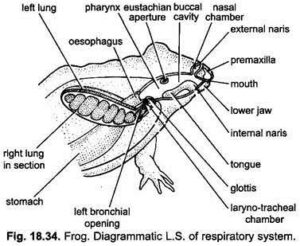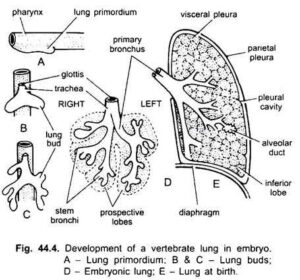Back to: ZOOLOGY 400 Level
Welcome to class!
Hello again, brilliant learner! I’m thrilled to have you back for another exciting lesson. Today, we’re going to explore a fascinating topic—comparative respiratory adaptations. This is all about how different animals have adapted their breathing systems to survive in their specific environments. From creatures that live under the sea to those that soar in the sky, each has a unique way of breathing. Let’s discover how!
Comparative Respiratory Adaptations
What Are Respiratory Adaptations?
Respiratory adaptations are the special changes in an organism’s respiratory system that help it survive and thrive in its environment. These adaptations allow organisms to take in oxygen and expel carbon dioxide efficiently, even in challenging conditions like low oxygen availability, extreme temperatures, or underwater environments. Let’s look at how different animals have adapted their respiratory systems based on their environments.

Adaptations in Aquatic Animals
Aquatic animals like fish, amphibians, and aquatic mammals face the challenge of extracting oxygen from water. Since water contains much less oxygen than air, these animals have developed unique ways to make the most of the oxygen available to them.
Fish
Fish have gills, specialized organs that allow them to extract oxygen from water. Water flows over the gills, and oxygen is absorbed into the fish’s bloodstream. Gills are designed to maximize the surface area for gas exchange, allowing fish to breathe efficiently even in oxygen-poor water.
Example: When you see a fish swimming in a river or pond, it’s constantly moving water over its gills. This helps it absorb oxygen from the water and release carbon dioxide, which is a waste product of metabolism.
Amphibians
Amphibians like frogs are unique in that they can breathe through their skin as well as their lungs. This is especially important for frogs that live in both water and on land. Their moist skin allows oxygen to diffuse directly into their bloodstream, which is why amphibians are often found near water sources.
Example: Frogs that are submerged in water absorb oxygen through their skin. When on land, they use their lungs to breathe in air.
Aquatic Mammals
Aquatic mammals, like whales, dolphins, and seals, breathe air, but they spend a lot of time underwater. They have blowholes on the top of their heads that allow them to breathe quickly at the surface before diving again. These animals can hold their breath for long periods while swimming, thanks to specialized adaptations in their respiratory systems.

Example: When a whale surfaces, it exhales forcefully through its blowhole to get rid of carbon dioxide and then inhales oxygen quickly before diving back down.
Adaptations in Terrestrial Animals
Terrestrial animals live on land, where oxygen is plentiful, but their respiratory systems have adapted to avoid dehydration and to breathe efficiently in dry conditions. These animals have developed ways to conserve moisture and maximize oxygen intake.
Insects
Insects have a tracheal system, which is a network of tiny tubes that deliver oxygen directly to their tissues. The tubes open to the outside through small holes called spiracles. This system helps insects get oxygen efficiently while preventing water loss, as they live in relatively dry environments.
Example: A grasshopper’s tracheal system carries oxygen directly to its tissues, and it controls the opening and closing of its spiracles to prevent excessive water loss.
Reptiles
Reptiles like lizards, snakes, and turtles have well-developed lungs, but their lungs are relatively simple compared to those of mammals. Reptiles have a rib cage that helps them breathe by expanding and contracting the chest. Some reptiles, such as snakes, have only one lung, which is adapted for long, efficient breaths.
Example: A snake’s long, narrow body and single large lung allow it to efficiently extract oxygen during breathing. This adaptation is useful for their elongated bodies and unique way of moving.
Mammals
Mammals, including humans, have highly developed lungs and a diaphragm—a large muscle that helps with inhalation and exhalation. Mammals have a high metabolic rate, meaning they require a constant supply of oxygen. Their lungs are designed to maximize gas exchange through tiny air sacs called alveoli.
Example: When you breathe in, the diaphragm moves down to allow air into your lungs, and the alveoli help exchange gases between the air and your blood.
Adaptations in Birds
Birds face a unique challenge because they need to extract a lot of oxygen to sustain the high energy demands of flight. Their respiratory system is extremely efficient, and it involves not only lungs but also air sacs.
Air Sacs
Birds have a system of air sacs that allow for continuous airflow through their lungs. This means that oxygen-rich air is always flowing through the lungs, even when they exhale. The air sacs act like bellows to push air through the lungs, ensuring that birds can get more oxygen per breath.

Example: When a bird inhales, the air flows into the air sacs, and when it exhales, the air moves into the lungs. This efficient system allows birds to get a continuous supply of oxygen, even during strenuous flight.
Summary
- Fish use gills to extract oxygen from water, even in oxygen-poor environments.
- Amphibians like frogs use both their lungs and skin for respiration, especially in aquatic environments.
- Aquatic mammals such as whales and dolphins have blowholes and can hold their breath for long periods underwater.
- Insects have a tracheal system with spiracles that efficiently deliver oxygen to tissues while minimizing water loss.
- Reptiles have lungs and a rib cage to help expand and contract their chest for breathing.
- Mammals have lungs with alveoli for efficient gas exchange and a diaphragm to help with breathing.
- Birds have a highly efficient respiratory system that includes lungs and air sacs, allowing for continuous oxygen flow.
Evaluation
- How do fish extract oxygen from water, and what is the role of gills in this process?
- Why can amphibians like frogs breathe through their skin, and how does this adaptation help them?
- How does the respiratory system of aquatic mammals like dolphins differ from that of terrestrial mammals?
- What is the function of the tracheal system in insects?
- How do birds manage to extract more oxygen during flight with their air sac system?
Fantastic work! You’ve just explored how different animals have developed incredible respiratory systems suited to their environments. It’s amazing how evolution has fine-tuned these systems for survival. Keep up the great effort, and remember that every lesson you complete brings you one step closer to mastering your knowledge of zoology. You’re doing awesome, and I can’t wait to see you keep soaring to new heights!
